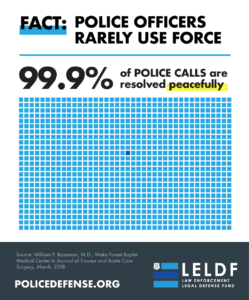Its definition is nebulous. Contorted definitions of “defunding” not meaning “defunding” abound. The phrase, now painted 20 feet high in the street across from the White House, seems to be catching on, with some lawmakers already endorsing it.
In Minneapolis, nine members of the City Council have vowed to “defund the police,” expressly “dismantling” the department and creating a “police free society.”
Meanwhile, Georgetown Law Professor Christy Lopez argues, “For most proponents, ‘defunding the police’ does not mean zeroing out budgets for public safety, and police abolition does not mean that police will disappear overnight — or perhaps ever.”
This is simply a kind of double-talk and convoluted definition of the term defund, which actually means, “to withdraw financial support from, especially as an instrument of legislative control” when less radical advocates want to co-opt the term. When Republicans wanted to “defund NPR,” they did not mean trim around the edges or downsize.
But what professor Lopez and the Washington Post editorial board really want instead is to narrow the scope of policing. As a veteran frontline officer and police executive, I wholeheartedly agree – with a few caveats and reality checks.
Putting aside the true police abolitionists and sloppy “defunding” language, effective police reform does require scaling back the duties and expectations that local governments and communities have for police. When all other government or community services have failed or are unavailable, the police are the agency of last resort. In curtailing these demands on limited policing resources, overburdened departments and officers can focus on their primary and essential duty: public safety and affect it with professionalism and skill.
Meanwhile, other more effective resources can be targeted at community needs that do not always requiring a police response. Notably, the homeless, substance abusers, and the mentally ill (often overlapping categories) need social services including counseling, medical attention, and housing instead of time in jail. Similarly, some domestic incidents do require police but in a support role with counselors on hand to resolve conflict.
The good news is a number of police departments already are doing this. Dozens of major departments have hybrid teams that partner social workers, counselors, medical personnel, and police to respond to these calls. While police officers across the country have improved their training for mental illness response, they are not fully equipped to handle them as specialists are. Cities like Houston have launched these collaborations to match the needs of the most vulnerable with the skills and resources of the city. Teams patrol and often only respond to calls that require specialists on scene.
These teams take different forms across the country but prioritize helping those in need more than enforcing the law on them. Before the progressive mantra became “defund,” prominent left-leaning justice reform group even praised the approach as a model for more effective policing outcomes.
But this approach is not really defunding as much as diverting resources and refocusing police roles. If properly executed, police may return to protecting the innocent full-time instead of, at present, a patrol officer wearing the hat of a social worker, grief counselor, dispute mediator as well as law enforcer.
Just as the maxim, “jack of all trades, master of none” goes, overstretching police duties diminishes their ability to excel at any one role.
Although many police departments have invested in training for these expanded duties, a fully professionalized law enforcement system requires high-level, exhaustive but narrow training. Only then can we set clear metrics for success and hold everyone fully accountable for their performance. By asking too much, we cannot expect under-trained and under-resourced to deliver results that meet our expectations.
Meanwhile, bolstering non-police support systems will take resources and time. Effective and efficient service delivery to the most vulnerable cannot be achieved overnight or by simply repurposing police budgets. Anyone with an understanding of institutional economics knows that every dollar newly infused into a city department does not have the same impact as an existing dollar. There are start-up costs and inefficiencies that take time to curtail. Moreover, substantively improving or “reforming” police performance, even with narrower police roles, requires and investment, not a divestment.
Thus, cutting money from police budgets and simply diverting them social programs, as the mayors of New York City and Los Angeles plan to do, will solve nothing and the problems may actually get worse before they get better.
And, part of the problem is that so many of the “defund” or abolish the police advocates have never experienced the bad times. Crime has fallen dramatically and almost continuously for nearly three decades. Thirty years ago, New York City logged 2,250 homicides. Last year, only 300 people were murdered there, even though its population has grown by 50% in those three decades. Victimization rates for all property and violent crime are less than half what they were. America is the safest it has been for 50 years – a privilege brought to you by the police.
To maintain public safety, we cannot and will not actually “defund the police.” But diverting some police funding may well make our police better and streets safer, if it’s done correctly.
(Jason Johnson is a former Deputy Commissioner of the Baltimore Police Department. He is currently President of the Alexandria, Virginia-based Law Enforcement Legal Defense Fund.)


